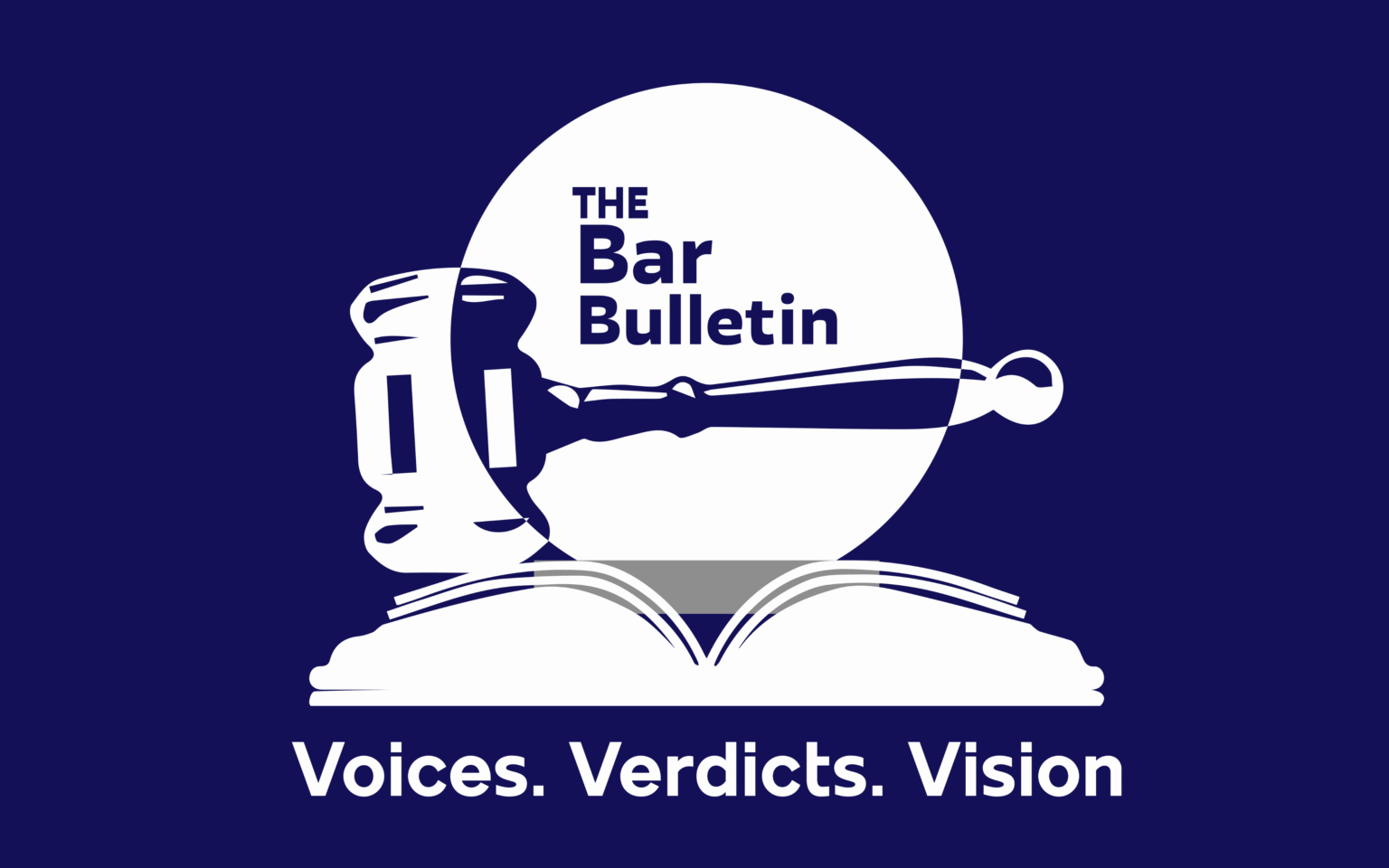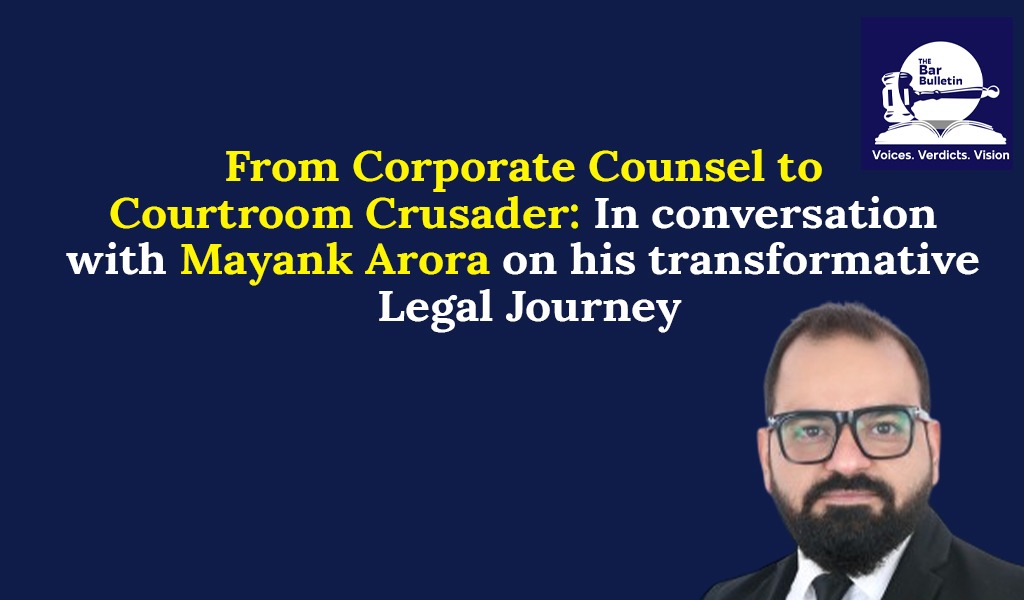Mayank began his career in the structured world of corporate law, where he honed his understanding of legal frameworks, organizational strategy, and stakeholder dynamics. However, he soon realized that his true calling lay beyond boardroom negotiations: in the courtroom, where the law is tested, justice is fought for, and societal impact is real. This conviction led him to shift from corporate counsel to litigator, and eventually to join Bharat Chugh Chambers as a Partner.
- Could you walk us through your journey into the legal profession? What inspired you to pursue law?
My journey into law was one of serendipity. I was mostly aimless and clueless about my career choice after having pursued my senior school with science optionals, and it was upon insistence of my close friends, who thought I am more suited to arguing in courts than doing science experiments. I decided to explore law as a profession since my close friends believed that I am more suited to ‘stand for a cause’ and can make reasonably good arguments to advance it.
- You began your career in the corporate legal sector—what prompted your shift to litigation, and how did your association with Bharat Chugh Chambers come about? How has the transition shaped your practice and growth as a Partner there?
My move from corporate to litigation was driven by a desire to shift from the mundane to making real change. Quite frankly, it was after years in the corporate world, I finally understood and recognized the real power of law to drive change, not just in business, but in society at large, across demographics and across all deserving groups.
While being in corporate world gave me a deep understanding of structures, strategies and people, it always believed it was litigation that truly spoke to me. Litigation, as I understood it, was not just about defending a case, it was about advocating for justice, fighting hard for it using one’s skills to the optimum. The courtroom is where the law is tested, where society’s rules are questioned, and where the truth ultimately prevails. After having taking care of things financially, paid my loans and having relieved myself of the pressure to earn month-on-month, I decided to take up advocacy and directly try to impact lives.
Joining Bharat was nothing short of a blessing and an honor at the same time. Having learnt to walk my first steps in the litigation world from Bharat himself ( which is true even today as I think I am still a curious child when it comes to litigation), Bharat’s mentoring allowed me to channel my strategic corporate experience into litigating high-stakes commercial and criminal matters. It is Bharat’s grace to put me on the pedestal of a Partner at the Chambers ( which I think I barely deserve). With his trust and belief giving me the comfort to fail in real time under his watchful eyes looking over my shoulder, it not only helped me fine-tune my courtroom craft but also be a part of a legal practice that is grounded in truth and strategy. Bharat made me embrace a world of legal practice where we believe and yearn for world view that transcends borders and conventional playbooks.
- What were some early challenges you faced in litigation practice, and how did you overcome them?
Litigation is clearly not for the faint-hearted. Early on, I was confronted with the unpredictable nature of the courtroom dynamics very, very long hours at work, (for the first year of my transition I used to regularly reach home not before 1 AM each night), cryptic briefs and lack of rigor at the trial stage even in meritorious matters and a sheer lack of strategy in many other legal battles.
All of this coupled with demanding clients and pressing timelines was simply mind boggling. One of my biggest early challenges was also managing the emotional intensity that often accompanies high-stakes matters. However, I quickly learned that preparation, knowing the law inside out, anticipating opposition strategies, and understanding the overbearing human element at play; is how one can succeed in most situations. I decided thereafter to embrace this uncertainty and challenge, knowing that every challenge in litigation is an opportunity to sharpen my skills, fortify my resolve, and redefine the boundaries of what’s possible and make real change.
- What emerging areas of law do you believe young litigators should pay close attention to in the next 5–10 years?
The future of law, I believe will be shaped by technology, data privacy, environment and global inter-connectedness with melting borders. Young litigators should be looking at areas where the legal landscape is still evolving: artificial intelligence, cybersecurity, white collar crimes which are taking place across internal and external borders, and the expanding realm of intellectual property law are some of the quick examples. These fields are ripe for innovation and will surely demand a new breed of litigators, those who can bridge the gap between technology and law while also keeping in mind the question of environment and sustainability. Environmental law is also bound to gain further prominence as the world confronts issues of sustainability and climate change.
The key for young lawyers will be to understand not just the statutes but the implications that these emerging areas have on business, organizations, governments and society at large. The future will seek lawyers who are honest, grounded, and digitally empowered. Lawyers who can cross-examine a witness and decode an IP log at the same time, Lawyers who can empathize with a domestic violence survivor and analyse metadata on her phone help her preserve evidence for her case. Lawyers who can draft with heart and argue with force. I think the young litigators will end up seeing a completely new world of litigation that is unfathomable today.
- You’ve mentored several young litigators. What’s one piece of advice you always give your juniors?
I always tell my fellow young lawyers – Master the craft and be well rounded in your approach, don’t just memorize the law alone. The law is an evolving discipline and is always applied in context, and it’s easy to fall into the trap of being unidimensional. True mastery of the profession may come from understanding people, embracing strategic thinking, mastering courtroom craft, and cultivating the power of persuasion.
In litigation, it’s not just about arguing facts, it’s about making the law, facts and the dynamics work for you. It’s the place where through an effective cross examination you and break the narrative and make truth breathe again. Young lawyers must develop a voice that resonates, a character that is unimpeachable, a style that commands attention, and the kind of resilience that never backs down, no matter how tough the case gets. Your lawyers need to look forward and upwards and help the profession evolve with them.
- What are your views on the current state of the Indian judicial system, particularly in terms of access to justice and delays?
“Justice doesn’t always roar. Sometimes, it whispers in the silence of a functioning society.”
The Indian judicial system to my understanding is robust and rooted in tradition and is still relevant and functional as it is today. I have seen empathetic judges who stay late just to ensure that they not only finish their cause-list but also hear the litigants fairly and/or dictate a fair orders when the system wants to rush a verdict.
But what’s also true is that Indian courts often operate under immense pressure, volume of cases, outdated infrastructure, shortage of judges . But still the system keeps a country of 1.4 billion people believe in the notion of justice and that’s simply magical.
While digital reforms and e-courts are steps in the right direction, I think the system still needs to evolve beyond these tools and empowerment at each level of Judiciary is the core need of the hour. The judges at trial court are trained to see past the noise and they are doing their best to serve the constitution and the citizens, but in absence of proper infra and ground level support, I think, they are not able to realize their full potential. The true measure of a judicial system isn’t just the volume of cases it handles, but how it delivers timely and accessible justice for all. So access to justice, is a function of empowerment of Judiciary, enhancement of infra, further embrace of technology.
- With the growth of arbitration and mediation, where do you see litigation fitting into the future legal landscape?
Arbitration and mediation are vital tools for dispute resolution, but I still feel courtroom litigation remains the backbone of the legal system. Arbitration offers efficiency; mediation help reconciliation and faster resolutions, but I still think the courtroom is where legal boundaries are set and tested. Litigation is where principles of justice, accountability, and public rights are actively upheld and it is still within the active reach of the common citizen.
Even as alternative dispute resolution mechanisms gain traction, litigation will continue to evolve and never fade or disappear. In fact, going by my understanding of this space now, litigation may become even more critical as concerns of ensuring that justice is served in its most transparent and accountable form will continue to be the primary reasons for citizens choosing litigation over arbitration and other modes of dispute resolution
- How do you think reforms like digitisation and e-courts have impacted litigation practice in India?
Digitisation and the introduction of e-courts have opened up tremendous possibilities for improving the accessibility and efficiency of our legal system. The ability to file documents online, track case progress, and attend hearings remotely has transformed how the common citizens interact with the courts. However, the key challenge remains the mindset of our system to adopt these change aggressively ensuring that the digital framework complements the procedural framework without sacrificing quality.
It’s not just about technology; it’s also about using it to enhance transparency, speed, and accessibility for all litigants. The true impact will be felt when these reforms are fully realized and internalized, making justice quicker, more efficient, and more equitable.
- How do you unwind or disconnect from the intensity of litigation practice?
The lawyer’s family is often the quiet co-accused—serving time for the advocate’s detentions.
My unwind is to focus on my family, especially spend some time with my daughter, travel with them and if time permits, occasional visits to the gym. There’s a certain grounding in being with loved ones, away from the courtroom. Beyond that, I read, learn about latest tech and AI, allowing me to wander into worlds outside of the legal text. Litigation is all-consuming, but I think to be at your very best in the courtroom, the key is to find small breaks/recesses in between the schedule and that is an absolute must, albeit tough.

